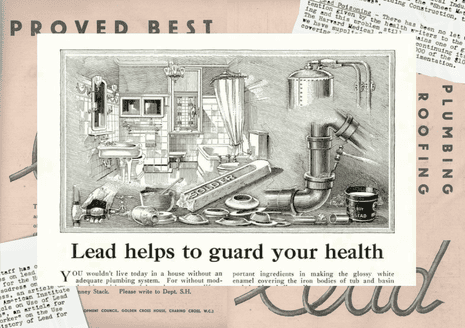
Advertisements and documents pushing for lead pipes.
Composite: National Geographic Society Internet Archives, Alamy, Toxic Docs
The lead water crisis facing Chicago and many other US cities today has roots in a nearly century-old campaign to boost the lead industry’s sales
The lead water crisis facing Chicago and many other US cities today has roots in a nearly century-old campaign to boost the lead industry’s sales
THE GUARDIAN
Thu 22 Sep 2022
LONG READ
LONG READ
The year was 1933 and, to a group of industrialists gathered in a New York City lunch club, it seemed like the lead industry was doomed.
The women’s pages of newspapers were filled with stories about children being poisoned by the metal, which had been identified as dangerous as early as the mid-1800s. And cities around America had started banning the use of lead pipes for drinking water.
Lead companies were looking for a way to keep their revenues flowing, but, as the secretary of the Lead Industries Association would warn them in a later report, lead poisoning was “taking money out of your pockets every day”.
So the Lead Industries Association, made up of all the major lead companies of the time, launched a two-pronged plan to revive the industry’s sales of lead pipe – a plan that is still threatening the health of millions of residents around the United States today, including in Chicago, where the industry’s tactics paid off spectacularly.

First, the association mounted an “intensive drive” to get cities to add requirements to their building codes saying that only lead pipes could be used to connect people’s homes to the water system. Secondly, it worked to convince plumbers to become lead advocates as well, urging them to keep cities dependent on complex lead work or risk losing their plumbing jobs to simple handymen.
The association hired two staff members to visit hundreds of city water departments and send out letters to thousands more – pushing the idea of making lead pipes mandatory in city codes. In addition, the association sent illustrated promotional materials to a list of 4,357 water departments and water companies in the US to encourage use of lead pipes.
“They had a big interest in selling this stuff and creating markets that were basically permanent,” said historian David Rosner, who co-authored a book with Gerald Markowitz on the lead industry’s tactics. He added: “They were really interested in making sure no bad news tarnished their product: bad news like ‘It’s killing kids’ or ‘It’s poisoning us’.”
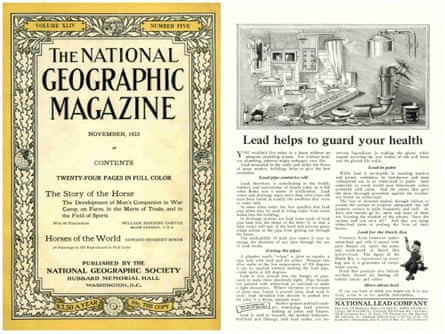
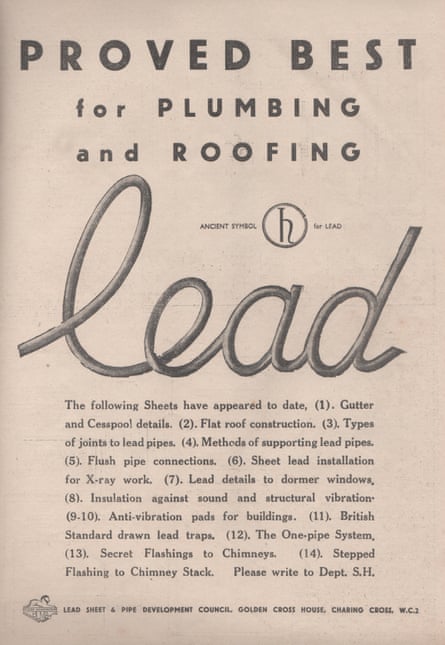
Vintage advertisements for the National Lead Company and the Lead Sheet and Pipe Development Council.
Photograph: National Geographic Society Internet Archives/ Alamy
Around the same time, the association sponsored university research to mount competing studies to those showing lead had dire effects on children’s brains and developing bodies. The staffers also worked to recruit plumbers, giving classes in leadwork for apprentices and hosting an exhibit seen by 30,000 plumbers who attended the national convention of master plumbers in Chicago in 1935.
Within six years, according to historical documents reviewed by the Guardian, the industry boasted of having succeeded in getting lead pipes required in the codes of two states and 33 major cities – from Philadelphia, Pennsylvania, and Buffalo, New York, to Austin, Texas. In the meantime, plumbers associations in 14 states had pledged their allegiance to using lead pipes.
“In city after city, where the continued use of lead was threatened by the encroachment of substitutes, we succeeded in protecting our interests by having lead introduced to plumbing codes where it had previously been omitted,” wrote Felix E Wormser, the lead industry association’s secretary, in a report to the organization’s board of directors in 1935.
The degree to which this plan still haunts American cities is chilling.
In Chicago, city officials are just beginning to figure out how to deal with the dangers to drinking water: lead pipes feed water to 400,000 homes there and will take at least $8bn to get rid of. In Buffalo, community groups are fighting to stop a lead poisoning epidemic that has taken a toll on several generations of the mostly black children in the city’s most impoverished neighborhoods. Meanwhile the Biden administration has secured $15bn in federal money to remove the menace that still lies under the ground in every state in the nation – but that is still only a third of what will be needed.
“A lot of public money is going to be spent to deal with the lead in water issue, but so much of this really goes back to the lead industry’s attempts to sell lead pipes,” said Rick Rabin, a health activist who was among the first to write about this in a journal article.
In Chicago, the industry’s strategy translated into decades of delay in banning lead pipes.
Around the same time, the association sponsored university research to mount competing studies to those showing lead had dire effects on children’s brains and developing bodies. The staffers also worked to recruit plumbers, giving classes in leadwork for apprentices and hosting an exhibit seen by 30,000 plumbers who attended the national convention of master plumbers in Chicago in 1935.
Within six years, according to historical documents reviewed by the Guardian, the industry boasted of having succeeded in getting lead pipes required in the codes of two states and 33 major cities – from Philadelphia, Pennsylvania, and Buffalo, New York, to Austin, Texas. In the meantime, plumbers associations in 14 states had pledged their allegiance to using lead pipes.
“In city after city, where the continued use of lead was threatened by the encroachment of substitutes, we succeeded in protecting our interests by having lead introduced to plumbing codes where it had previously been omitted,” wrote Felix E Wormser, the lead industry association’s secretary, in a report to the organization’s board of directors in 1935.
The degree to which this plan still haunts American cities is chilling.
In Chicago, city officials are just beginning to figure out how to deal with the dangers to drinking water: lead pipes feed water to 400,000 homes there and will take at least $8bn to get rid of. In Buffalo, community groups are fighting to stop a lead poisoning epidemic that has taken a toll on several generations of the mostly black children in the city’s most impoverished neighborhoods. Meanwhile the Biden administration has secured $15bn in federal money to remove the menace that still lies under the ground in every state in the nation – but that is still only a third of what will be needed.
“A lot of public money is going to be spent to deal with the lead in water issue, but so much of this really goes back to the lead industry’s attempts to sell lead pipes,” said Rick Rabin, a health activist who was among the first to write about this in a journal article.
In Chicago, the industry’s strategy translated into decades of delay in banning lead pipes.
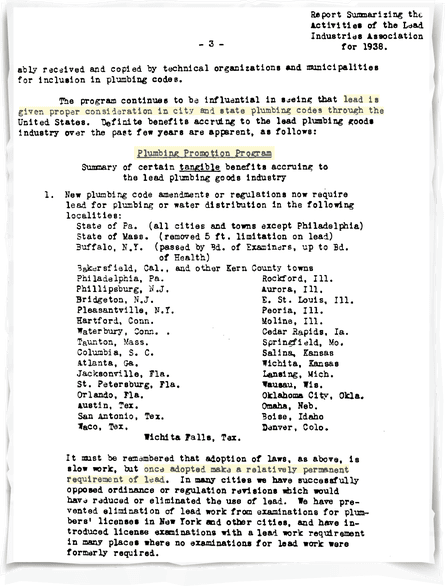
Excerpt of a 1938 activities report from the January 1939 Lead Industries Association board of directors meeting. Composite: Toxic Docs
Just ask Julius Ballanco, a longtime Chicago plumbing engineer. When he got his first taste of the plumbing industry, as a teenager working in his father’s New Jersey plumbing business in the 1960s, lead was everywhere.
He remembers spending cold, rainy mornings sitting in a trench, breathing in the fumes from a pot of melting lead, which the plumbers of the time used for the painstaking job of soldering together lead or cast iron pipe.
“You’d come home and your hands would be shining because the lead got into your skin, giving us lead poisoning,” said Ballanco. “I often wonder if I’d be a little smarter today if I hadn’t had to deal with lead.”
After going to university to become a plumbing engineer, Ballanco moved to Chicago and learned just how entrenched the toxic metal had become in the city. He joined a national engineering organization trying to get lead requirements out of city building codes.
By then, the lead industry’s sales campaign had ended and most cities had long since banned lead pipes, recognizing the danger of childhood lead poisoning. But Chicago’s plumbers, according to news articles and accounts from the time, were still championing lead for its durability and bendable nature.
In Chicago, the city code still said in early 1986 that any pipe 2in or less in diameter connecting a home to the water system had to be lead – and plumbers fought to keep that rule in place for decades, news accounts suggest.
Back in the 1930s, the city had been the home base of the lead industry’s midwest campaign to promote lead pipe and its plumbers’ organizations became a forceful ally.
The Lead Industries Association had assigned field men to attend the national plumbing convention in Chicago with the goal of “arousing the master and journeyman plumbers to the danger to their own profession of turning away from lead”.
Just ask Julius Ballanco, a longtime Chicago plumbing engineer. When he got his first taste of the plumbing industry, as a teenager working in his father’s New Jersey plumbing business in the 1960s, lead was everywhere.
He remembers spending cold, rainy mornings sitting in a trench, breathing in the fumes from a pot of melting lead, which the plumbers of the time used for the painstaking job of soldering together lead or cast iron pipe.
“You’d come home and your hands would be shining because the lead got into your skin, giving us lead poisoning,” said Ballanco. “I often wonder if I’d be a little smarter today if I hadn’t had to deal with lead.”
After going to university to become a plumbing engineer, Ballanco moved to Chicago and learned just how entrenched the toxic metal had become in the city. He joined a national engineering organization trying to get lead requirements out of city building codes.
By then, the lead industry’s sales campaign had ended and most cities had long since banned lead pipes, recognizing the danger of childhood lead poisoning. But Chicago’s plumbers, according to news articles and accounts from the time, were still championing lead for its durability and bendable nature.
In Chicago, the city code still said in early 1986 that any pipe 2in or less in diameter connecting a home to the water system had to be lead – and plumbers fought to keep that rule in place for decades, news accounts suggest.
Back in the 1930s, the city had been the home base of the lead industry’s midwest campaign to promote lead pipe and its plumbers’ organizations became a forceful ally.
The Lead Industries Association had assigned field men to attend the national plumbing convention in Chicago with the goal of “arousing the master and journeyman plumbers to the danger to their own profession of turning away from lead”.
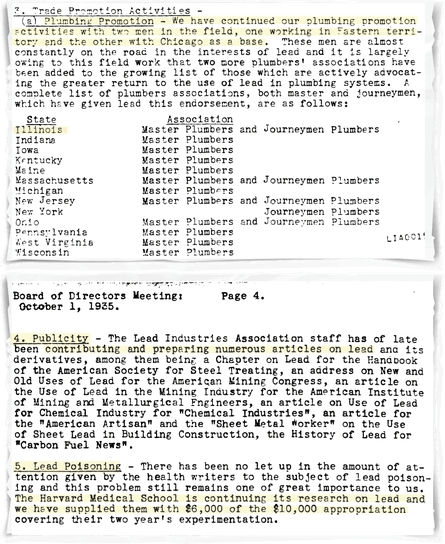
Excerpt from the October 1935 Lead Industries Association board of directors meeting.
Composite: Toxic Docs
In return, Chicago plumbers enthusiastically promoted the industry – as was seen in an article written for the industry’s Lead magazine at the time.
“I am happy to say that the lead industry […] has cooperated fully with the plumber to strengthen and improve plumbing ordinances all over the country,” John J Calnan, a Chicago plumber, wrote in a piece for Lead magazine in 1934.
Within a few years, Lead magazine published an article commending Chicago city officials for allowing only lead service lines in the city’s code.
The support for lead lines was cemented in the 1950s, as the plumbers union became particularly powerful in the city, according to reporting by Chicago broadcaster WBEZ. The union’s leader, Stephen Bailey, marshaled hundreds of thousands of labor votes to help elect his boyhood friend, Mayor Richard J Daley, who remained in office until the mid-1970s.
This in turn was said to have given the plumbers sway over the city’s plumbing codes.
“As everybody in Chicago knows, you scratch my back and I’ll scratch yours,” John McHugh, a veteran Chicago journalist who authored a book on the Chicago plumbers, told reporter Monica Eng of WBEZ.

In return, Chicago plumbers enthusiastically promoted the industry – as was seen in an article written for the industry’s Lead magazine at the time.
“I am happy to say that the lead industry […] has cooperated fully with the plumber to strengthen and improve plumbing ordinances all over the country,” John J Calnan, a Chicago plumber, wrote in a piece for Lead magazine in 1934.
Within a few years, Lead magazine published an article commending Chicago city officials for allowing only lead service lines in the city’s code.
The support for lead lines was cemented in the 1950s, as the plumbers union became particularly powerful in the city, according to reporting by Chicago broadcaster WBEZ. The union’s leader, Stephen Bailey, marshaled hundreds of thousands of labor votes to help elect his boyhood friend, Mayor Richard J Daley, who remained in office until the mid-1970s.
This in turn was said to have given the plumbers sway over the city’s plumbing codes.
“As everybody in Chicago knows, you scratch my back and I’ll scratch yours,” John McHugh, a veteran Chicago journalist who authored a book on the Chicago plumbers, told reporter Monica Eng of WBEZ.

Legion of Honor members at the St Patrick’s Day Parade on State Street. Pictured, from left, are: Dan Ryan Jr, Robert Quinn, Mayor Richard J Daley, Stephen Bailey of the Plumbers Union and Monsignor Francis Byrne.
Photograph: Courtesy of University of Illinois at Chicago. Library. Special Collections and University Archives Department (Richard J Daley Library)
Daley and Bailey could be seen marching arm in arm in Chicago’s St Patrick’s Day Parade, sponsored by the plumbers, who dye the city’s river shamrock green for the famous event every year.
In 1986, Harold Washington, Chicago’s first black mayor, tried to buck the union. He proposed taking the lead requirement out of the code, after hearing from the health department that 1,644 children in the city were suffering from high levels of lead in their blood.
By then every other major city in the nation had banned lead pipes and Ballanco’s engineering organization was urging Chicago to adopt a model city code that excluded lead as well.
But the plumbers’ union stood its ground and opposed the measure, and thus it failed to win approval from the city’s aldermen.
“Lead [pipes] have proven over a long time to do the job they were designed to do,” Jim McCarthy, the union’s business manager, told the Chicago Tribune at the time. “I’m hard-pressed to understand why people are talking about lead poisoning. We’ve had lead pipe in the water system here for 100 years.”
James Majerowicz, the current president of the Chicago Journeymen Plumbers’ and Technical Engineers, local union 130, said he was involved with the plumbers back in 1986, but didn’t believe they opposed stopping the installation of lead pipes.
“I don’t remember the plumbers being opposed to it,” said Majerowicz. “I find that difficult to believe, because we’ve always been looking out for public safety and health.”
He said that today “we are 100% behind replacing lead services. It has been proven now that lead is not that good.”
But, according to Ballanco, until the federal government banned lead pipes in 1986, Chicago continued to install them. The city’s long delay in banning the pipes is why Chicago has more lead pipes than any other city in the nation.
“There’s still a lot of lead in Chicago,” said Ballanco, who has now founded his own engineering company and is still working to help Chicago get rid of the lead. “Does it hurt the children growing up? Sure, it does. Does it impact their mental capacity and decrease their ability? Yes, it does.”
Five hundred miles east in the rust belt city of Buffalo, community members are finally mobilizing to get rid of the lead pipes that the pitchmen of the Lead Industries Association once sold their city leaders.
An investigation by Reuters found the city has one of the worst lead poisoning problems in the nation – with more than 40% of children having elevated blood lead levels in some zip codes.
Not only did the Lead Industries Association boast to its membership about getting lead codified in Buffalo’s plumbing codes, it promoted the use of lead for federal public housing projects built in the city, too. The association’s Lead magazine published a 1939 article praising the federal government for using 20 tons of lead pipe and 40 tons of lead caulking in constructing two Buffalo housing projects, which were some of the first public housing in the nation where black residents were allowed.
“By the use of lead services for these projects, the authorities have taken a further judicious step toward assuring low maintenance cost,” said the article, which argued lead was the only material with all the characteristics to provide “adequate health protection” and urged more use of lead in constructing public housing.
Stephanie Simeon is fighting the effects of all that lead every day, not only as a community organizer in Buffalo, but as a mom.
As the executive director of the Buffalo non-profit Heart of the City Neighborhoods, Simeon is leading a campaign to help the city raise the funds and spur the community engagement needed to get rid of its buried lead pipes. Her adopted daughter, now 11, suffered lead poisoning as a baby and is now struggling to overcome a host of developmental delays.
“Our kids are having low educational attainment and our schools have high rates of suspension,” she said, noting that lead has been linked to learning disabilities and behavioral problems in children. “We can do better than this. This is one of the richest nations in the world.”
When the Guardian shared documents with her showing how the lead industry once pushed to get its product written into Buffalo’s city code, she was outraged.
“It’s disgusting,” said Simeon, who said industry should have to pay for the lasting damage to children done by its profiteering.
But legal efforts to hold the industry accountable for lead poisoning caused by paint and leaded gasoline, which were both promoted by the Lead Industries Association as well, have mostly faltered. The association itself went bankrupt in 2002, saying it could not afford insurance to fight off lawsuits.
“It was profit over people,” said Simeon. “Now we’re paying for it.”
Daley and Bailey could be seen marching arm in arm in Chicago’s St Patrick’s Day Parade, sponsored by the plumbers, who dye the city’s river shamrock green for the famous event every year.
In 1986, Harold Washington, Chicago’s first black mayor, tried to buck the union. He proposed taking the lead requirement out of the code, after hearing from the health department that 1,644 children in the city were suffering from high levels of lead in their blood.
By then every other major city in the nation had banned lead pipes and Ballanco’s engineering organization was urging Chicago to adopt a model city code that excluded lead as well.
But the plumbers’ union stood its ground and opposed the measure, and thus it failed to win approval from the city’s aldermen.
“Lead [pipes] have proven over a long time to do the job they were designed to do,” Jim McCarthy, the union’s business manager, told the Chicago Tribune at the time. “I’m hard-pressed to understand why people are talking about lead poisoning. We’ve had lead pipe in the water system here for 100 years.”
James Majerowicz, the current president of the Chicago Journeymen Plumbers’ and Technical Engineers, local union 130, said he was involved with the plumbers back in 1986, but didn’t believe they opposed stopping the installation of lead pipes.
“I don’t remember the plumbers being opposed to it,” said Majerowicz. “I find that difficult to believe, because we’ve always been looking out for public safety and health.”
He said that today “we are 100% behind replacing lead services. It has been proven now that lead is not that good.”
But, according to Ballanco, until the federal government banned lead pipes in 1986, Chicago continued to install them. The city’s long delay in banning the pipes is why Chicago has more lead pipes than any other city in the nation.
“There’s still a lot of lead in Chicago,” said Ballanco, who has now founded his own engineering company and is still working to help Chicago get rid of the lead. “Does it hurt the children growing up? Sure, it does. Does it impact their mental capacity and decrease their ability? Yes, it does.”
Five hundred miles east in the rust belt city of Buffalo, community members are finally mobilizing to get rid of the lead pipes that the pitchmen of the Lead Industries Association once sold their city leaders.
An investigation by Reuters found the city has one of the worst lead poisoning problems in the nation – with more than 40% of children having elevated blood lead levels in some zip codes.
Not only did the Lead Industries Association boast to its membership about getting lead codified in Buffalo’s plumbing codes, it promoted the use of lead for federal public housing projects built in the city, too. The association’s Lead magazine published a 1939 article praising the federal government for using 20 tons of lead pipe and 40 tons of lead caulking in constructing two Buffalo housing projects, which were some of the first public housing in the nation where black residents were allowed.
“By the use of lead services for these projects, the authorities have taken a further judicious step toward assuring low maintenance cost,” said the article, which argued lead was the only material with all the characteristics to provide “adequate health protection” and urged more use of lead in constructing public housing.
Stephanie Simeon is fighting the effects of all that lead every day, not only as a community organizer in Buffalo, but as a mom.
As the executive director of the Buffalo non-profit Heart of the City Neighborhoods, Simeon is leading a campaign to help the city raise the funds and spur the community engagement needed to get rid of its buried lead pipes. Her adopted daughter, now 11, suffered lead poisoning as a baby and is now struggling to overcome a host of developmental delays.
“Our kids are having low educational attainment and our schools have high rates of suspension,” she said, noting that lead has been linked to learning disabilities and behavioral problems in children. “We can do better than this. This is one of the richest nations in the world.”
When the Guardian shared documents with her showing how the lead industry once pushed to get its product written into Buffalo’s city code, she was outraged.
“It’s disgusting,” said Simeon, who said industry should have to pay for the lasting damage to children done by its profiteering.
But legal efforts to hold the industry accountable for lead poisoning caused by paint and leaded gasoline, which were both promoted by the Lead Industries Association as well, have mostly faltered. The association itself went bankrupt in 2002, saying it could not afford insurance to fight off lawsuits.
“It was profit over people,” said Simeon. “Now we’re paying for it.”
No comments:
Post a Comment